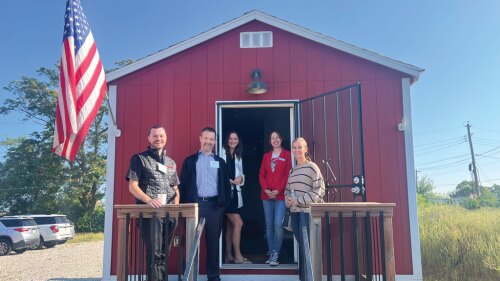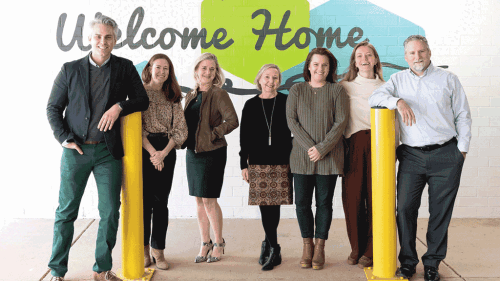Architects designing government buildings have to work with often-contradictory requirements: embody authority and solidity, yet also convey the transparency and openness of democracy. Make sure the structures address concerns of security and resilience while remaining accessible and welcoming to the public. Stick to tight budgets while folding in community spaces and creating environments that do not feel institutional or stodgy.
The following ten projects—all completed over the past five years—take creative approaches to resolving these contradictions. Strategies include covering a city hall with residents’ fingerprints, adapting and expanding a historic bank building to host parliamentary gatherings, enlarging civic green spaces, giving the public a front-row seat to the process of recycling curbside materials, and creating exhibition rooms for schoolchildren to learn about seed conservation.
1. 11 West Quincy Court
Chicago, Illinois
Ludwig Mies van der Rohe’s Chicago Federal Center, a three-building complex organized around a plaza, has been a model of rectilinear rigor in Chicago’s downtown since the project’s completion in 1974. As part of the expansion of the complex, the U.S. General Services Administration asked Denver-based 4240 Architecture to modernize an office building next door, originally built as the Bond Department Store in 1948, so that it could house federal offices and retail space. To strengthen connections to the federal center, the designers relocated the building’s entrance from the south side to the north side, linking it to the pedestrian plaza that leads to the federal center’s U.S. courthouse.
Solid walls on the north and west sides were replaced with glass facades to bring in natural light. Ceramic fritting on the new curtain wall along State Street references the lines of Sol LeWitt’s aluminum sculpture Lines in Four Directions, which has hung from the west elevation since the 1980s. The project was completed in 2012.
2. Australian PlantBank
Mount Annan, New South Wales, Australia
Australia’s Royal Botanic Gardens and Domain Trust created the Australian PlantBank to hold its seed bank, support researchers studying the country’s indigenous seeds, and help to share that research with the public. Located at the Australian Botanic Garden in Mount Annan and designed by the Sydney office of BVN, the science and research facility merges with its bushland setting. On the exterior, mirrored panels reflect the landscape, alternating with large windows shaded by metal screens. Use of low-combustibility materials protects the structure and its seed vault from the danger of bushfires.
BVN oriented the curving building in response to the local climate and sun exposure. Operable glass louvers allow for natural ventilation as part of the mixed-mode mechanical system. Intended to educate schoolchildren and the public, the building includes conference facilities and exhibition rooms where visitors can watch scientists carrying out research in their laboratories and peer into the cold-storage facilities and seed vault. The facility was completed in 2013.
3. Deventer City Hall
Deventer, Netherlands
Deventer’s city hall literally has citizens’ fingerprints all over it. Neutelings Riedijk Architects of Rotterdam renovated the historic city hall and more than quadrupled its size with the addition of new construction, bringing municipal employees together under one roof. For the facades, the firm teamed up with local artist Loes ten Anscher to develop a series of aluminum grids that depict the fingerprints of more than 2,200 Deventer residents.
Following the city’s tradition of gardens, squares, and alleys, the ground floor contains a public passageway linking Deventer’s two main squares on either side. The building itself has two primary internal public spaces: an open courtyard and a covered atrium. Extensive glazing brings in natural light, while the concrete structure helps moderate temperatures. The structure also makes use of water from the IJssel River for heating and cooling. The project was completed in 2016.
4. Judge Seymour Gelber and Judge William E. Gladstone Miami-Dade Children’s Courthouse
Miami, Florida
For young people, attending court can be intimidating. To replace an obsolete, overcrowded juvenile justice center, Miami–Dade County brought in the Tampa, Florida, office of HOK and local firm Perez & Perez Architects Planners to design a 14-story building that would ease access to services and create a welcoming, healthy environment. A precast concrete screen wall on the south facade gives a playful impression with its multicolored windows, scattered in an irregular pattern. Public art throughout ranges from bear sculptures in the lobby to large-scale murals and tile installations created by area public school students.
Located a short walk away from the Government Center intermodal transit hub, the building occupies the northern edge of its site, leaving room on the southern portion for a new shaded public plaza across the street from an existing park. Sustainable strategies include a green roof above the lower atrium lobby, permeable paving, and native plants. Completed in 2015, the facility includes 18 courtrooms, judges’ chambers, and administrative offices; support agencies for families are centralized on three floors.
5. Newport Beach Civic Center and Park
Newport Beach, California
At the heart of the southern California city of Newport Beach lay a long, narrow, 20-acre (8 ha) wedge of degraded wetlands, considered unbuildable because of height restrictions intended to preserve views from existing buildings. In 2016, a new civic center opened on the site, including a city hall, park, library addition, and parking garage surrounding a new civic green. Illuminated by plentiful natural light, the narrow city hall is topped by a wave-shaped roof that extends beyond the building to provide shade. Newport Beach’s temperate climate obviated the need for a grand lobby. Instead, each city department has its own entrance accessed from the outside.
Paths wind through the park and across a pedestrian bridge, which extends over a nine-lane thoroughfare to a new dog park at the site’s northeastern tip. A lookout tower gives the public access to ocean views. San Francisco–based Bohlin Cywinski Jackson designed the buildings and worked with PWP Landscape Architecture of Berkeley, California, to create the park, which incorporates native and drought-tolerant landscaping and restored wetlands. The civic center was completed in 2013.
6. Salt Lake City Public Safety Building
Salt Lake City, Utah
To replace a dilapidated, cramped 1950s-era public safety building, Salt Lake City completed a new one in 2013 that is designed to generate as much energy as it consumes or more, remain operational even after a 7.5-magnitude earthquake, resist bullets and bomb blasts, and supply its own power if the electric grid goes down. The public face of the structure is a serpentine, angled glass curtain wall that reveals the activity within and looks out onto a new public festival plaza created as part of the project.
Anchoring the east end of the Civic Center district, the facility houses the city’s police and fire departments as well as the regional disaster/emergency operations center. The structural system consists of a steel moment frame with viscous dampers to resist damage from seismic events. Insulated precast concrete panels faced with terra-cotta offer thermal mass to moderate temperatures. Rooftop and off-site photovoltaic systems are supplemented by a solar canopy that extends over the plaza and provides outlets for the public to charge devices. Local firm GSBS Architects designed the building, with Phoenix-based MWL Architects as associate architects.
7. Sir John A. Macdonald Building
Ottawa, Ontario, Canada
The Beaux-Arts Bank of Montreal Building has had a stately presence across the street from the west block of Ottawa’s Parliament Hill since the 1930s. Owned by the government since the 1970s and vacant since the bank moved out a decade ago, it remained empty until the government repurposed the edifice to serve as a government conference center and ceremonial hall.
The local office of NORR, in association with local firm MTBA, restored the grandeur of the granite and limestone building, including the main hall’s elaborate coffered ceiling, while inserting modern security and building systems. On an adjacent empty lot, NORR designed a new two-story pavilion that draws on the material palette and proportions of the bank building but with a contemporary interpretation. The addition fills a gap in the street edge and connects to the old structure via a new glass-enclosed atrium, which is set back from the street to preserve views to the historic building’s western facade. The project was completed in 2015.
8. Sunset Park Material Recovery Facility
New York, New York
As part of New York City’s efforts to increase recycling, the city’s sanitation department, department of small-business services, and economic development corporation teamed up with Brooklyn-based Sims Municipal Recycling to revamp an old waterfront pier on Gowanus Bay into the primary processing center for curbside metal, glass, and plastic recyclables. Receiving these materials by barge eliminates 240,000 miles (386,000 km) of vehicle travel from roadways each year. Local firm Selldorf Architects relied almost entirely on recycled steel for the buildings and incorporated recycled glass, asphalt, and rock into the complex, which includes tipping, processing, and bale storage buildings as well as a visitor center and administration building.
The visitor center contains classrooms, exhibitions, and interactive demonstration displays for school groups and members of the public. A pedestrian bridge leads visitors to a viewing platform that lets them see the processing facility in action. The entire site was elevated four feet (1.2 m) to protect from flooding and sea-level rise. Completed in 2013, the facility includes one of New York City’s largest photovoltaic installations, a wind turbine, and bioswales and ponds for managing stormwater. Local firm Steven Gambino Architects served as architect of record for the processing facility buildings.
9. United States Courthouse, Austin, Texas
Austin, Texas
For the United States Courthouse, Austin, Texas, the U.S. General Services Administration wanted a facility that would bring natural light and views into all courtrooms and public spaces. To achieve this on a tight downtown site, Mack Scogin Merrill Elam Architects of Atlanta configured the seven-story building as a cube and organized rooms in an interlocking arrangement of double-height courtrooms and stacked single-story jury rooms and judges’ chambers.
A little-used street was turned into a landscaped plaza, which links the courthouse to the existing Republic Square Park. Civic and cultural events, including a weekly farmers market, can overflow from the park into the plaza and up the courthouse steps. The architects collaborated with New York City artist Clifford Ross to create The Austin Wall, a painted and stained glass wall that separates the first-floor main lobby from the jury assembly room. The wall’s motorized doors pivot open to link the two spaces for public events. The courthouse opened in 2012.
10. United States Courthouse, Cedar Rapids, Iowa
Cedar Rapids, Iowa
The Iowa flood of 2008 caused extensive damage to civic and commercial buildings in the downtown, but the release of federal funds in response to the disaster allowed for the long-awaited construction of a new courthouse to help catalyze rebuilding. Placed on a brownfield site along the Cedar River, at the end of one of the downtown’s principal streets, the building is raised nine feet (3 m) above ground level to protect it from future floods. A seven-story glass curtain wall on the north elevation brings natural light into corridors and makes the entrances to all courtrooms visible to the public from street level.
A powder-coated steel sculpture by artist Ralph Helmick of Newton, Massachusetts, hangs from the ceiling of the six-story glazed atrium. The building gently curves around a landscaped green that connects to the Cedar River Trail along the water. Boston-based William Rawn Associates, with the local office of OPN Architects as associate architect, designed the building for the U.S. General Services Administration. The project was completed in 2012.
Ron Nyren is a freelance architecture, urban design, and real estate writer based in the San Francisco Bay area.

















